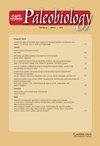Environmental correlates of molluscan predator–prey body size in the northern Gulf of Mexico
IF 2.7
2区 地球科学
Q2 BIODIVERSITY CONSERVATION
引用次数: 0
Abstract
The Mississippi River delivers tremendous amounts of freshwater and nutrients to the northern Gulf of Mexico, which results in the explosive growth of phytoplankton populations that are typically nutrient limited. Decomposition of phytoplankton blooms by aerobic bacteria can deplete oxygen concentrations in coastal systems, leading to the establishment of oxygen-limited “dead zones.” Changes in the availability of food and dissolved oxygen, as well as changes in temperature, can have wide-reaching effects on coastal food webs. Here, we investigate how primary productivity, dissolved oxygen, and sea-surface temperature affect the sizes of molluscan predators and prey in the northern Gulf of Mexico using collections of shells preserved in seafloor sediment on the continental shelf. We find that the size of bivalves, and the frequency of predatory drilling by snails, are most affected by dissolved oxygen: prey size increases and drilling predation decreases with decreasing concentrations of dissolved oxygen. Sea-surface temperature is positively associated with the size of both molluscan predators and prey. In contrast, net primary productivity has little direct association with size, and the predator-to-prey size ratio also does not vary consistently with environmental conditions in the northern gulf. Larger bivalves in areas with lower oxygen could reflect reduced pressure from predators and, consequently, greater life spans. Larger predator and prey sizes in warmer waters may reflect more optimal conditions for growth. The shells of recently deceased bivalves, and the associated traces of drilling snails on those shells, can be used to investigate long-standing hypotheses about the roles of environmental variation in body-size evolution through geologic time. Furthermore, future studies comparing these historical data with data from present-day communities may help us understand how coastal food webs are changing in response to various human activities.墨西哥湾北部软体动物捕食者-猎物体型的环境相关性
密西西比河向墨西哥湾北部输送了大量的淡水和营养物质,这导致了通常营养物质有限的浮游植物种群的爆炸性增长。好氧细菌对浮游植物大量繁殖的分解会耗尽沿海系统中的氧气浓度,导致氧气受限的“死区”的建立。食物供应和溶解氧的变化,以及温度的变化,会对沿海食物网产生广泛的影响。在这里,我们研究了初级生产力、溶解氧和海面温度如何影响墨西哥湾北部软体动物捕食者和猎物的大小,使用了保存在大陆架海底沉积物中的贝壳集合。研究发现,溶解氧对双壳类动物的大小和蜗牛捕食性钻食的频率影响最大,随着溶解氧浓度的降低,猎物大小增加,钻食减少。海洋表面温度与软体动物捕食者和猎物的大小呈正相关。相比之下,净初级生产力与大小几乎没有直接联系,捕食者与猎物的大小比也不随环境条件而持续变化。在氧气含量较低的地区,体型较大的双壳类动物可能反映出来自捕食者的压力减少,因此寿命更长。在温暖的水域中,更大的捕食者和猎物可能反映出更理想的生长条件。最近死亡的双壳类动物的壳,以及在这些壳上钻探蜗牛的相关痕迹,可以用来研究长期存在的关于环境变化在地质时期体型进化中的作用的假设。此外,未来的研究将这些历史数据与现代社区的数据进行比较,可能有助于我们了解沿海食物网如何响应各种人类活动而发生变化。
本文章由计算机程序翻译,如有差异,请以英文原文为准。
求助全文
约1分钟内获得全文
求助全文
来源期刊

Paleobiology
地学-古生物学
CiteScore
5.30
自引率
3.70%
发文量
38
审稿时长
>12 weeks
期刊介绍:
Paleobiology publishes original contributions of any length (but normally 10-50 manuscript pages) dealing with any aspect of biological paleontology. Emphasis is placed on biological or paleobiological processes and patterns, including macroevolution, extinction, diversification, speciation, functional morphology, bio-geography, phylogeny, paleoecology, molecular paleontology, taphonomy, natural selection and patterns of variation, abundance, and distribution in space and time, among others. Taxonomic papers are welcome if they have significant and broad applications. Papers concerning research on recent organisms and systems are appropriate if they are of particular interest to paleontologists. Papers should typically interest readers from more than one specialty. Proposals for symposium volumes should be discussed in advance with the editors.
 求助内容:
求助内容: 应助结果提醒方式:
应助结果提醒方式:


